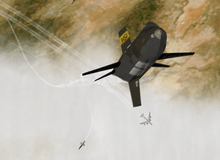X-15 Flight 3-65-97
 Crash site | |
| Mission type | Test flight |
|---|---|
| Mission duration | 10 minutes, 35 seconds |
| Apogee | 81 kilometres (266,000 ft) |
| Spacecraft properties | |
| Spacecraft | X-15 56-6672 |
| Crew | |
| Crew size | 1 |
| Members | Michael J. Adams |
| Start of mission | |
| Launch date | 15 November 1967, 18:30:07 UTC |
| Launch site |
Balls 8, Edwards Dropped over Delamar Dry Lake |
| End of mission | |
| Destroyed |
15 November 1967, 18:40:42 UTC Broke up over Randsburg, California 35°25′10.68″N 117°36′2.00″W / 35.4196333°N 117.6005556°WCoordinates: 35°25′10.68″N 117°36′2.00″W / 35.4196333°N 117.6005556°W |
X-15 Flight 3-65-97, also known as X-15 Flight 191, was a test flight of the North American X-15 experimental aircraft. It took place on November 15, 1967 and was piloted by Michael J. Adams. It ended in tragedy when the aircraft broke apart minutes after launch due to technical difficulties, killing the pilot and destroying the plane.
Mission overview

Adams' seventh X-15 flight took place on November 15, 1967 in the number three aircraft. At 10:30 in the morning on November 15, the X-15-3 dropped away from underneath the wing of NB-52B mothership at 45,000 ft (14,000 m) over Delamar Dry Lake.
While in powered flight, an electrical disturbance distracted Adams and slightly degraded the control of the aircraft; having adequate backup controls, Adams continued. At 10:33 he reached a peak altitude of 266,000 ft (81,000 m). In the NASA 1 control room, mission controller Pete Knight monitored the mission with a team of engineers.
As the X-15 climbed, Adams began a planned wing-rocking (rolling) maneuver so an on-board camera could scan the horizon. At the conclusion of the wing-rocking portion of the climb, the X-15 had begun a slow drift in heading; 40 seconds later, when the aircraft had reached its maximum altitude, it was off heading by 15 degrees to the left. As Adams came over the top, the drift briefly halted as the aircraft's nose yawed 15 degrees back to the correct attitude. Then the drift to the left began again; within 30 seconds, Adams' descending flight path was at right angles to the attitude of the aircraft. At 230,000 ft (70,000 m), while descending into the rapidly increasing density of the atmosphere, the X-15 entered a Mach 5 spin.
In the NASA 1 control room, there was no way to monitor the heading of the aircraft, so the situation was unknown to the engineers monitoring the flight. Normal conversation continued between Knight and Adams, with Knight advising Adams that he was "a little bit high," but in "real good shape." Adams radioed that the aircraft "[seemed] squirrelly," and moments later repeatedly told Knight that he had entered a spin. The ground controllers sought to get the X-15 straightened out, but there was no recommended spin recovery technique for the X-15, and engineers knew nothing about the aircraft's supersonic spin tendencies. The chase pilots, realizing that the X-15 would never make Rogers Dry Lake, headed for the emergency lakes, Ballarat and Cuddeback, in case Adams attempted an emergency landing.
Adams held the X-15's controls against the spin, using both the flight controls and the reaction control jets in the nose and wings. He managed to recover from the spin at 118,000 feet and went into an inverted Mach 4.7 dive at an angle between 40 and 45 degrees. In theory, Adams was in a good position to roll upright, pull out of the dive and set up a landing. However, due to high gain in the adaptive control system, the X-15 went into pilot induced oscillation with rapid pitching motion of increasing severity, still in a dive at 160,000 feet per minute. As the X-15 neared 65,000 ft (20,000 m), it was diving at Mach 3.93 and experiencing more than 15 g vertically, and 8g laterally.
The aircraft broke up northeast of the town of Johannesburg 10 minutes and 35 seconds after launch. An Air Force pilot, who was filling in for another chase pilot, spotted the main wreckage northwest of Cuddeback Lake. The aircraft was destroyed, and Adams was killed.
Investigation
NASA and the Air Force convened an accident board. Chaired by NASA's Donald R. Bellman, the board took two months to prepare its report. Ground parties scoured the countryside looking for wreckage, specifically the film from the cockpit camera. The weekend after the accident, an unofficial NASA Dryden Flight Research Center search party found the camera, but could not find the film cartridge. FRC engineer Victor W. Horton organized a search and on November 29, during the first pass over the area, Willard E. Dives found the cassette.
The accident board found that the cockpit instrumentation had been functioning properly, and concluded that Adams had lost control of the X-15 as a result of a combination of distraction, misinterpretation of his instrumentation display, and possible vertigo. The electrical disturbance early in the flight degraded the overall effectiveness of the aircraft's control system and further added to pilot workload.
The board made two major recommendations: install a telemetered heading indicator in the control room, visible to the flight controller; and medically screen X-15 pilot candidates for labyrinth (vertigo) sensitivity. As a result of the X-15's crash, the FRC added a ground-based "8 ball" attitude indicator (Horton's idea) in the control room to furnish mission controllers with real time pitch, roll, yaw, heading, angle of attack, and sideslip information.
References
- Robert Godwin, ed. (2000). X-15: The NASA Mission Reports. ISBN 1-896522-65-3.
- Hypersonics Before the Shuttle: A Concise History of the X-15 Research Airplane
- X-15 research results with a selected bibliography
External links
| ||||||||||||